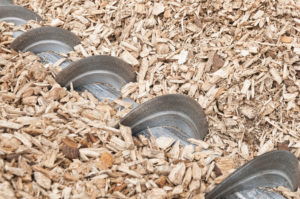John Field of TEAM (EAA) explains how to make the most of returns from biomass Renewable Heat Incentive schemes.
The Renewable Heat Incentive is the UK government’s world-leading subsidy scheme to encourage switching from fossil fuel heating to renewable heating sources. Like all world-leaders it is not without imperfections and controversy.
The scheme was set up for non-domestic sectors (including multi-residential) and is just starting for the domestic sector with significantly changed criteria for approval and metering, which are not addressed here.
The non-domestic RHI scheme was set up to parallel the extensive range of support schemes for renewable electricity and immediately that begs the question of why there have been few heating subsidy schemes. The answer highlights a critical issue: electricity is easy to meter and heat is not. Alongside that, heating systems have complex flows and usually involve traditional non-renewable heating plant – often in ways (like immersion heaters in domestic hot water cylinders) that have been taken for granted or even actively disregarded by the industry until you need to know whether the heat you are using is from a renewable thermal source which an electric immersion heater is not.
One thing is for certain, that the scheme is achieving significant momentum – unlike a certain other planet-saving scheme. An obvious reason for this is the high subsidy tariffs, which determine how much you are paid by the government for each kWh of eligible heat output from your approved system. Another reason – more arguable – is that the Department of Energy & Climate Change and Ofgem have got on with the business of developing a scheme with pragmatic procedures to work around the bigger issues. This has a flip-side in that the application and approval processes are a little complicated; on the other hand the issues are substantial and one could challenge critics to come up with a better approach.
Of the renewable heat technologies covered by the scheme, solid biomass has been the undoubted front runner to date, receiving the majority of the subsidy payments. Ground source heat pumps come in second and air source heat pumps are a late entry with some promise. Also included are solar thermal, biogas, deep geothermal, energy from waste and biomethane injection into the grid.
A universal theme has been that the relevant heat flows have to be metered (except for small fractions of system heat such as some buried pipework heat losses) and as metering air-transported heat directly is virtually impossible, the scheme concerns mainly water and steam-based heating generation, even if the heat is eventually emitted by air handling plant.
The scheme guarantees payments over 20 years (indexed upwards for inflation) for properly metered and reported renewable heat from an approved system. Typical annual payments are £40,000 a year for medium biomass and £11,000 for small biomass. Multiply that by 20 years and you have some very big numbers by the standards of energy-saving support schemes.
A key concept in the above is obtaining approval from Ofgem, which manages the scheme on behalf of DECC. Potential installations have to be put through an application process, which is designed (and updated from time to time under a supposed simplification banner) to establish that the basic criteria for subsidy are complied with. It also ensures that the eligible renewable heat output can be metered and not increased either fraudulently or accidently by, for example, a retained gas boiler.
Application for biomass RHI approval is therefore a process requiring a wide range of information and evidence and a stated engineering base for the metering: in many cases other than the simplest, this application must be supported by an extensive engineer’s report (again with evidence) setting down how the metering achieves the scheme criteria. This report is titled the “Independent Report on Metering Arrangements” (IRMA) and has to be carried out by an “unbiased and impartial” engineer who can demonstrate suitable experience and expertise in heat metering.
TEAM has highly qualified engineers with a track record of delivering successful IRMAs and RHI applications for a wide range of public and private sector clients including supermarkets, police authorities, NHS and local authorities.
The application process is described at length in publicly available documents on the Ofgem RHI website, which you can access directly and Ofgem has included some brave attempts at an introductory guide, with dos, don’ts and common errors.
Another thorny issue is the long-term picture for the subsidy tariffs. While the tariffs for approved schemes are fixed at the time of approval for 20 years (apart from upwards indexing) there is an uneasy period between committing to a renewable installation – issuing an order to a supplier/installer – and approval that follows design, installation, commissioning, gathering application information, submission to Ofgem, review by Ofgem, resolving any queries (most applications have queries) and approval by Ofgem. Much of this period comes after payment is due to the contractor which usually follows commissioning.
There is confusion and some misinformation about when the subsidy starts. An approved scheme receives payments for eligible heat in arrears on a quarterly basis according to metered data submitted quarterly to Ofgem by the scheme owner or their agent. The first quarter starts at the time of the first meter reads, which are an important part of the submission of an application to Ofgem – if the application is approved without major queries the heat generated during the review and approval time is all subsidised and the tariff is fixed at the date of the first meter reads.
However, if significant changes are required to the installation or the application, the application must be re-submitted with a new first reading so the intervening heat subsidy has been lost.
Potentially more seriously, the tariff will be fixed from the new first meter reads and the tariff levels may have been reduced in the meantime.
The time taken for Ofgem to review applications is an important part of the above processes. Our experience has shown that this can be as little as two weeks for high quality applications and longer for more complex ones. The quality of the information provided makes a significant difference in avoiding review delays , formal queries and their resolution.
Concerning longer-term tariff projections, the term degression is used for tariff reduction by Ofgem to prevent the number of applications mushrooming out of control, as they did with solar photovoltaic Feed-in Tariffs in October 2011.
DECC has set up a quarterly review process that looks at application levels and gives notice of any reductions (degression) of tariffs in the next quarter. These changes have been small to date, typically 5%, but that adds up over a 20-year project and there may be more than one degression before an installation is approved if approval times are extended.
DECC has a separate tariff review process, which has been used so far to increase selected tariffs in order to boost take-up of technologies that are not receiving RHI applications and subsidies.
The overall picture at present is therefore that this is a significant scheme with potentially large and long-term subsidy payments but that the application process requires considerable expertise, attention and planning. Barring major revisions to the whole scheme (or worse), the process for longer-term review of tariffs is fairly well set down and can therefore be planned for. we&e
TEAM is currently providing IRMA reports to clients ranging from large retail stores to housing associations across the UK. Energy consultant Justine Grant is co-author of the B&ES Guide to Good Practice: Heat Metering for the RHI, while energy consultant Princess Opara is part of the Ofgem RHI Industry Advisory Group led by Jacqueline Balian, head of RHI operations




